1. Introduction
The principle behind
orthodontics is to use external force to rearrange the position of the teeth and
make them straight. Uneven teeth will not only influence our looks but could also
cause more serious problems, such as tooth decay, periodontal disease and temporomandibular joint disease. Orthodontic
treatment is a safe and effective way to solve these problems for both children
and adults.
2. Illustration of orthodontic procedures and introduction of dentists
Dr.Toshio Ishizuka
Graduateted from Dental Prosthesis at the School of Dentistry, Nagasaki University in Japan.
Over 20years of experience
General Dental diagnosis and treatment including orthodontic and implant treatment.
Dr. Sophia Wang
Active member in good standing of the International Congress of Oral Implantologists.
Active member in good standing of the Chinese Stomatological Association.
Active member in good standing of the Shanghai Stomatological Association.
Continued her study of orthodontics at the "Today is" Dental Clinic in the USA (2009).
An expert in prosthodontics and orthodontic treatments, as well as general dental diagnoses.
Highly skilled in reducing patient anxiety with her gentle and professional manner.
3. Frequently Asked Questions
1)What makes teeth become uneven?
Uneven teeth are generally caused either by congenital genetic factors or by
acquired environmental factors, such as disease, poor oral habits, dental
abnormalities during the developmental period, or malocclusions like overbite
and underbite.
There are a wide variety of factors that can cause uneven teeth, (with
heredity usually accounting for about 30%), including the following:
· Poor oral habits (such as finger sucking, lip biting, chewing only on one
side, etc.)
· Being born with too many teeth
· Congenital missing teeth
· Premature loss of deciduous (baby) teeth
· Retained deciduous (baby) teeth
· Cleft lip and palate
· Endocrine factors
· Malnutrition
· Vitamin deficiency
· A communicable disease
· Facial hypertrophy psychosis
2)What can we do to help prevent uneven teeth?
Uneven teeth caused by genetic factors cannot be prevented, but potential
deformities from acquired factors can and should be prevented. Parents should
pay attention to the oral health of their children’s deciduous (baby) teeth,
guiding and teaching them how to brush their teeth correctly for example.
Secondly, parents need to correct any bad oral habits their children may develop
as soon as they become aware of them, such as lip biting and finger biting, also
can prevent some malocclusion deformities. Additionally, parents should prepare
some chewy food when feeding their children, rather than making all their food
too soft. Proper chewing is useful for stimulating healthy jawbone development,
and this can also help to prevent uneven or lost teeth.
3)What’s the harm of having uneven teeth?
Firstly, having uneven teeth will be very detrimental to facial appearance,
and can make people (both children and adults) feel frustrated and upset,
resulting in a loss of self-confidence. Moreover, this loss of confidence may
reducing the amount of time a person spends caring for their own personal oral
health, which in turn could lead to a greater likelihood of cavities, gum
disease and other oral diseases. If these health concerns are not treated in a
timely manner, not only will our appearance and confidence suffer, but there is
a real risk of adversely affecting our oral health and tooth functioning.
4) What are the different methods used for orthodontics?
The dental appliances (commonly called braces) used for orthodontics
treatments can be divided into three categories: removable braces, functional
braces, and fixed braces. The majority of clinical patients (approximately 80%
to 90%) choose to use fixed metal (steel) braces. Also, if conditions allow,
patients can choose to wear clear aligner style braces, which are nearly
invisible, and will present a noticeably better appearance.
The most common types of braces are shown below:

5)How long do orthodontic treatments usually last?
Orthodontic treatments
can be broadly divided into two phases: the treatment period and the retention
period.
· The treatment period takes about one to two years. During this
time, the patient must wear a fixed appliance (braces) and will need to see the
dentist an average of every four to six weeks to have the braces adjusted.
Later, once all of the teeth are in alignment the dentist will remove the fixed
braces. However, the treatment is not finished yet.
· Next comes the
retaining period, which generally can take over two years. Now that the braces
have been removed, the patient will instead need to wear a retainer which,
unlike the fixed braces, can be taken off by the patient. During the first six
months, the patient should wear the retainer day and night - except when eating.
After six months, the retainer should be worn every night, but not during the
day. One year later, the retainer only needs to be worn every other night,
gradually extending the intervals between wearing the retainer.
This whole
orthodontic treatment program will take years for treating and retaining, but
with a little patience, the end result will be perfectly straight and aligned
teeth.
6)Can adults also undergo orthodontic treatments?
Technically, there are
no age limits for orthodontic treatments, so long as the patient has healthy
gums. In fact, over one-third of all orthodontics patients in Europe and the
United States are adults.
Whether the patient is 60 years old or 12 years
old, there is not much effective difference in how well or how quickly teeth can
be realigned during an orthodontics treatment, although the speed may be a
little slower for adults. Compared with orthodontic treatments for children,
adult cases may be more complicated since adults are more likely to have some
oral health issues such as cavities, tooth decay, gum disease, or missing teeth. Shanghai dental dentists should always deal with any oral diseases first before starting any
orthodontics treatment.
7)Can orthodontic treatments be done for children younger than 12 years of
age? When is the best time
to bring children to see a dentist?
The
American Orthodontics Association has recommended that the best time to start a
child’s orthodontic treatment is at seven years old since many issues needing
correction often occur during this period. If these issues are discovered in
time, early correction will be relatively easy. However, the case becomes more
complicated after all of the child’s permanent teeth come in. If, after
inspection, there is no need for corrective orthodontic treatment, the dentist
can still give the parents some useful suggestions, such as what kind of dental
problems the child may have and when is the best time to do orthodontics
treatment.
8)Will patients suffer any pain from the orthodontics treatment?
Patients
may feel a little bit sore or experience some discomfort for the first two to
three days, caused by the body’s normal response to the initial orthodontic
treatment. However, in general, any feelings of pain or discomfort should
disappear quite quickly. During any orthodontic treatment, patients should
abstain from eating any hard foods (like bones) or sticky foods.
9) Will teeth become loose after having orthodontics done?
While some
people may worry about orthodontia causing older teeth to fall out prematurely,
this view is unscientific and unfounded. In fact, orthodontic treatment is a
slow process of realigning teeth with a gentle force. The side of each tooth has
some mobility and will be slowly moved until the new bone structure on the other
side of the tooth has regrown. This continues until all of the teeth are in
their proper positions. The procedure is gradual, and the teeth remain steady
and stable throughout. Professional orthodontic treatment will not cause any
harm to the teeth or gums.
10) What are some things we need to pay special attention to?
After having
worn braces for a long time, patients may feel that their teeth are sore and
weak after removal. So they should eat soft foods, such as rice, porridge, etc.,
at first to avoid increasing any feelings of discomfort. Normal dining can begin
again after one week, but 0sticky foods are not allowed for one or two years
after starting orthodontic treatment. Ignoring this advice will not only
increase the cost of the treatment and the number of visits to the dentist, but
will also extend the amount of time needed for the orthodontic treatment.
In
the meantime, patients need to take in enough calcium and vitamins during the
period of orthodontic treatment.
Good oral hygiene is likewise very
important. Patients must brush their teeth every morning, evening and after
meals, and keep their braces and teeth clean. Otherwise, food debris could
accumulate on the braces, allowing bacteria to grow, which could corrode the
braces and cause tooth decay and swollen gums. We recommend using a child’s
toothbrush with a small head and soft bristles. You should brush gently and
slowly, for between three to five minutes. If you find brushing after each meal
to be too inconvenient, you can at least rinse out your mouth with mouthwash
after every meal.
4.Successful Orthodontics Cases
Case 1) Successful Orthodontics Case for a 5-Year-Old Girl With Underbite
This is a 5-year-old girl, with sunken face. Her chin tilted to one side when
smiling. Her mother told that she had long expected to bring her daughter to
dental doctor. Well, with so many worries, like worrying about whether her girl
will cooperate, whether she will feel painful or whether her daughter can adapt
to it and so forth, the treatment is put off. Now, seeing the more and more
sunken and awry face of her daughter, she realizes the urgency of treatment.
After 7-month’s treatment in our iSMILE Dental Clinic, the underbite has been
regulated properly. Now, both the girl and her parents are very happy because of
her natural, confident and beautiful smile!
Before treatment:
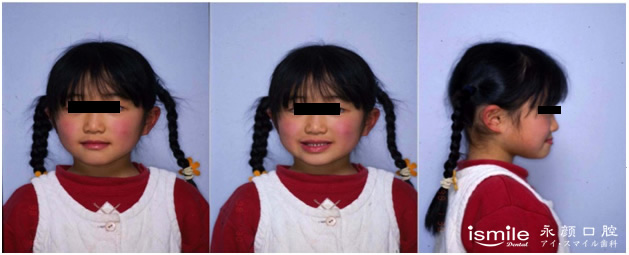

After treatment:
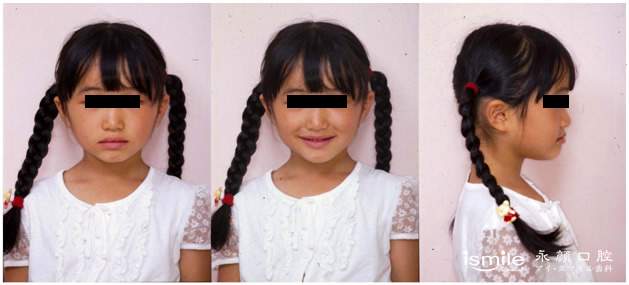

Case 2) Successful Orthodontics Case for a 10-Year-Old Boy With Underbite
Boy, 10 years old, the central section of his face was sunken and his lower
face was preumbonal. He was frequently confronted with the problems of being
laughed at by his classmates for his appearance shape. Now, after one-year’s
orthodontic treatment, his appearance shape has been greatly improved. We have
been friends with our patient and he comes to see us frequently.
|
10 years old (before treatment)
|
12 years old (face and profile are maintained well)
|
18 years old (face and profile are still kept well)
|

|
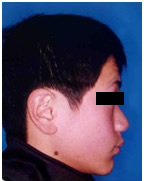
|
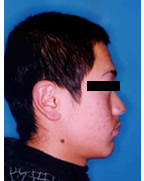
|
Case 3) Successful Orthodontics Case for Adult With Underbite
Male, more than 20 years old now, his families showed less care to his
underbite when he was still a kid since it didn’t affect his face actually. So,
no treatment was given. Now, the underbite affects not only his face, but also
his daily life, like eating. He chose us iSMILE Dental Clinic. The treatment is
the combination of operation and orthodontic treatment. There is a preoperative
treatment for over a year, then orthographic surgery, and orthodontics after the
surgery to adjust the dental occlusion. Well, his tooth function has been
greatly improved, and the front and side facial appearances are beautiful. He
can smile confidently now…
Before treatment:
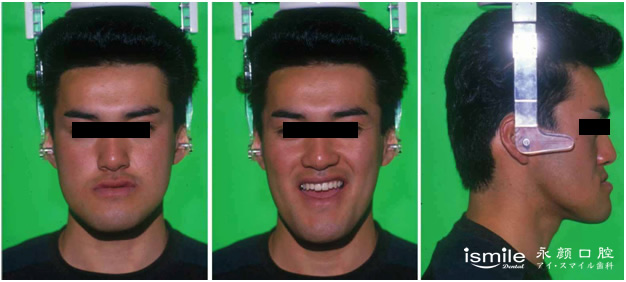

After treatment:



